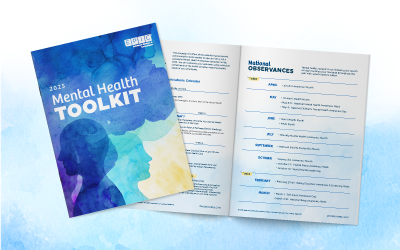HEALTH & WELLBEING
World Mental Health Day: Feel Empowered About Your Mental Health… Every Day
Viewpoints from Erin Milliken and Kerry Connor
Mental health and emotional wellbeing are two terms that are used interchangeably in our day-to-day lives. Though both are related, it is important to understand the differences and techniques to improve both.
Mental health involves overall psychological wellbeing – which includes a person’s emotional wellbeing and is based on how a person feels, acts, and thinks through life’s challenges. Emotional wellbeing refers to an individual’s ability to handle and express emotions when facing challenges. For instance, when a person faces a mental health struggle like anxiety or stress (typically normal and more common than we’d like), emotional health plays a role in a person’s ability to handle that anxiety or stress appropriately. Emotional wellbeing is all about keeping life and its challenges in perspective.
The top two stressors in a person’s day-to-day life stem from finances and the workplace. According to the American Institute of Stress, 83% of U.S. workers suffer from work-related stress, with 25% saying their job is the number one stressor in their lives.
Employers play a big role here. When it comes to productivity, engagement, and morale, the workplace sets the stage in many ways to assist folks with managing their mental health and emotional wellbeing.
So, what can employers do to help?
One of the first things we recommend is understanding your population. Your employees are unique and come from different walks of life. Social Determinants of Health (SDoH), which are those non-medical factors that impact an individual’s wellbeing, should be a pivotal consideration for employers. Examples of SDoH include socioeconomic status, access to healthcare, health literacy, ethnicity, and race. These factors deeply impact mental, physical, and emotional wellbeing. Employers should survey their employees to find out what they need and how they can provide that assistance.
Though employers play a huge role, it is ultimately up to each person to take action.
Taking those first steps should feel empowering, not paralyzing. A way to quickly reframe this thinking is to remember that one small action taken in a day can make a significant impact. A five- to 10-minute brisk walk can be as impactful as spending hours outside when it comes to managing your emotions. Sometimes we think carving out ten minutes won’t move the needle, so we do nothing. But we are here to tell you not to let the “perfect way” stand in the way of making progress!
At EPIC, we are passionate about wellbeing today, tomorrow, and every day.
Contact your EPIC team member if you’d like to learn more about our Wellbeing services or Voluntary Benefits. If you aren’t a client yet, we’d love to hear from you directly – reach out to Erin and Kerry. We look forward to working with you!
Want more insights into SDoH and what other companies are doing with their wellness programs?
The 2023 Trends in Workplace Wellness Report is out now!
Related Content
Products
Employee Benefits Consulting
Our dedicated benefits team is focused on delivering better outcomes – to both your benefits program and ...
Products
Wellbeing & Health Management
Our consultants help you create a strategy around health management that will impact your culture and your ...
Products
Voluntary Benefits
Our Voluntary Benefits Team manages the marketing, enrollment, education and ongoing program administration ...



